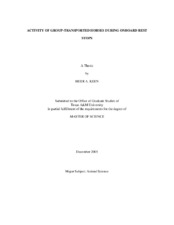| dc.description.abstract | Activity of group-transported horses was evaluated during onboard rest stops to
determine if horses derive meaningful rest. A single-deck semi-trailer separated into
three compartments was used for all shipments. In Experiment One, twelve video
cameras were used to record behavior of horses during five, 16 to 20 h shipments, with a
high (397.44kg/m2), medium (348.48 kg/m2) and low (220.91 kg/m2) density group in
each shipment. One-hour rest stops occurred after 8 h of transport and prior to unloading,
during which two groups were provided water. Movement of each horse visible on video
was quantified by counting the number of times the head crossed the vertical and/or
horizontal axes of the body at the withers. Mean number of movements per 5-min
interval in each group (n=13) was used to compare effects of density, access to water, and
order of stops. The high and low-density watered groups had increased activity during
the first 10 min of both rest stops potentially due to maneuvering for access to water. The
medium-density watered groups had increased activity during the first 10 min of only the
second rest stop. Activity slightly increased in the medium and low-density groups after
55 min possibly indicating adequate rest, but a similar increase did not occur in highdensity
groups. In Experiment Two, two shipments, lasting 23 h and 24 h respectively,
consisted of three groups of horses loaded at high density (397.32 kg/m2). Ninety-minute
rest stops occurred after every 6 h of transport and prior to unloading for a total of three rest stops. Percentage of visible horses "active" was averaged across each 5-min interval
of the stop. Activity was highly variable within and between shipments. Activity was
high at the beginning of stops one and three of Shipment One. A similar but less
dramatic settling occurred at the start of all three rest stops in Shipment Two. Twenty
three of thirty-four noted increases in alertness were due to aggression or noises outside
the trailer. In both experiments horses remained active during all stops indicating fatigue
had not become a major factor in these studies. | en |


